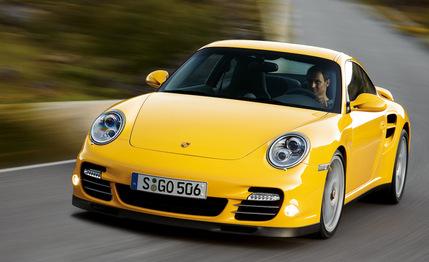
 First Drive Review
First Drive Review


When the Porsche 911 Turbo was introduced in Europe 35 years ago, the company thought the market for the car would be satiated after 500 units were sold. Now, after selling 80,000 examples spanning six generations of Turbos, Porsche is making yet another round of improvements, halfway through the life of the current 997 model.
Powered Up
As always with 911 Turbos, the engine is the star of the car and gets the lion’s share of the upgrades for this revised model. For the first time since the advent of the water-cooled models, this 2010 Turbo uses the same construction as that of the standard 911 engines, which were themselves updated last year.
This means that rather than using cylinder blocks separate from the crankcase halves, the Turbo
now uses an integrated casting on each side, reducing the parts count and cutting weight. The elaborate dry-sump-lubrication system, with its external tank, has also been changed to the standard 911 design with an integrated oil reservoir at the bottom of the engine, although separated from the crankcase. However, in the Turbo’s case, six—rather than four—oil-scavenge pumps are used to return oil to this reservoir because the two turbochargers each require a dedicated oil return.
Rather than the Nikasil hard-surface coating used on the cylinder walls of previous Turbos, this one relies on the hard surface produced by etching the Alusil block casting. Although Porsche engineers cringe when we say it, this is the metallurgy that debuted on the Chevrolet Vega about 40 years ago and has since been perfected on many German engines. The new turbo engine goes up in displacement from 3600cc to 3800cc due to increases in the bore and stroke dimensions, which are identical to those of the current Carrera S engine and fractionally less oversquare than the dimensions in the 3797cc 911 GT3 engine.
The new engine gets direct fuel injection, as did the Carrera and Carrera S powerplants last year. This is particularly beneficial to a turbocharged engine, as the cooling effect of the fuel vaporizing in the combustion chamber allows an increased compression ratio—which has risen from 9.0:1 to 9.8:1. Slightly larger intake valves help with filling the cylinders, as does an intake manifold adapted from the GT2, which employs expansion chambers in the intake runners to further cool the incoming charge. Slightly larger compressor wheels for the variable geometry turbochargers, more-efficient intercoolers, and refined exhaust system improve airflow through the engine.
As a result, the 2010 engine is about 22 pounds lighter than the previous one—quite an achievement since the direct fuel injection system adds about 18 pounds due to heavier components mandated by its much higher operating pressure. Peak horsepower has increased from 480 to 500; torque is up from 457 lb-ft to 479 lb-ft, despite a drop in maximum boost pressure from 14.5 psi to 11.6 psi. And with the optional Sport Chrono Package Turbo, an overboost function raises peak torque to 516 lb-ft for up to 10 seconds. EPA fuel-economy figures are unavailable, but Porsche claims the engine changes have reduced fuel consumption on the European tests by 10 percent.
That’s with the standard six-speed manual gearbox. However, the new model gets a beefed-up version of Porsche’s seven-speed PDK twin-clutch automated manual as an option. This transmission is much like the one introduced last year on the regular 911, except that it gets larger-diameter clutch plates as well as an extra pair in each pack to cope with the Turbo engine’s greater torque. It has taller ratios in third through sixth gears to better match the elevated output. With this transmission, Porsche says European fuel-economy figures have improved by 16 percent compared with those of the five-speed Tiptronic transmission that will no longer be offered. Finally, in response to complaints about the somewhat cumbersome steering-wheel-mounted shift buttons introduced with the PDK transmission on the Carrera models, Porsche is offering an optional PDK sport steering wheel with large separate shift paddles that are fixed to the steering-wheel hub. The right paddle upshifts the gearbox, and the left one handles downshifts.
Improved Grunt Management
To make the most of the increased power, this latest 911 Turbo gets a thoroughly revised suspension along with a new feature to enhance handling and address some of the dynamic issues that had elicited complaints on the previous car—from Car and Driver, among others. The software that controls the BorgWarner-sourced all-wheel-drive system and determines the amount of torque sent to the front wheels has been revised and now feeds power to the front more gradually than before. Put simply, the system allows more tire slip in the rear before it sends torque forward, slowing the transition from oversteer to understeer.